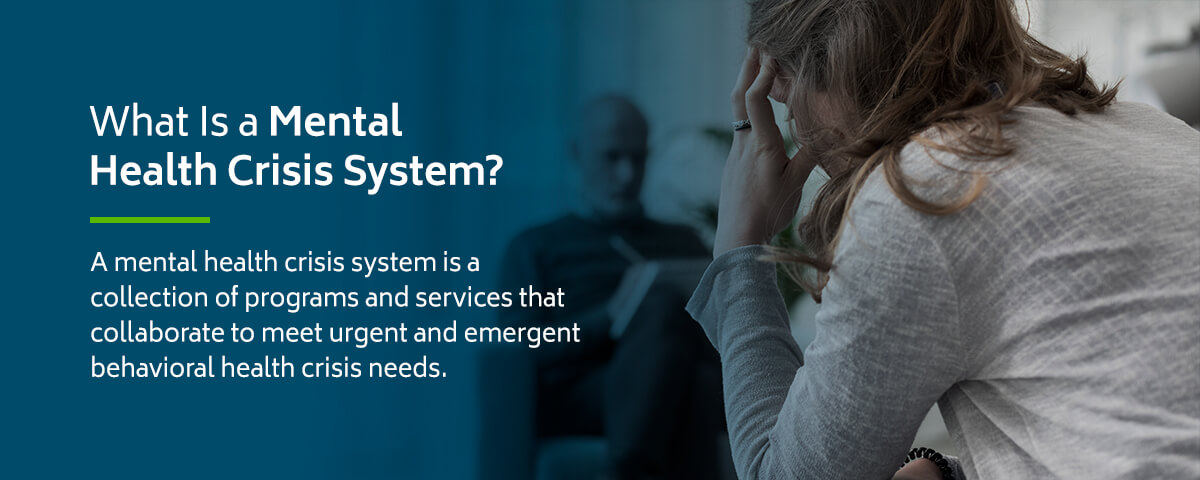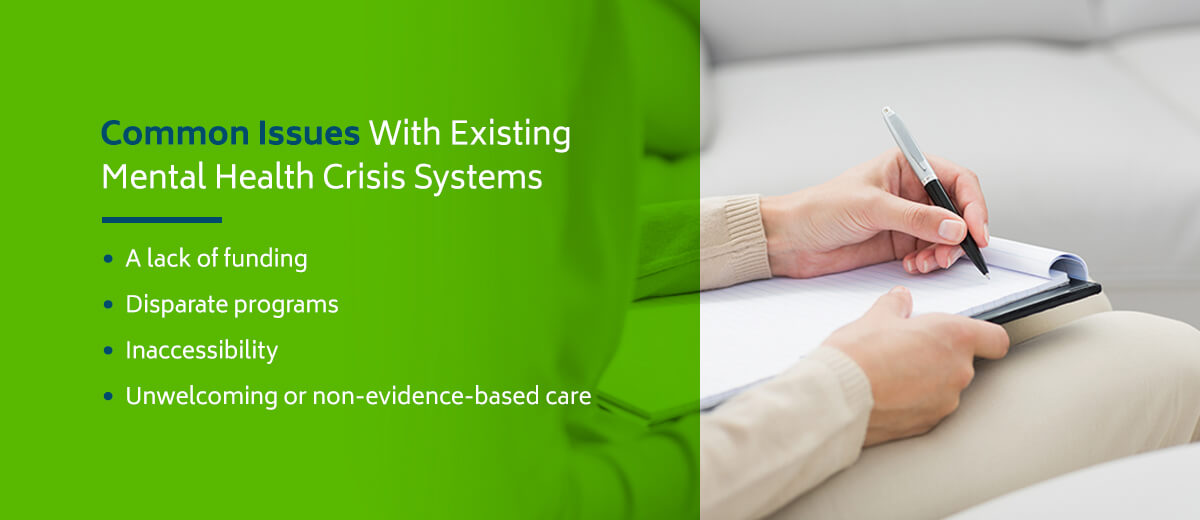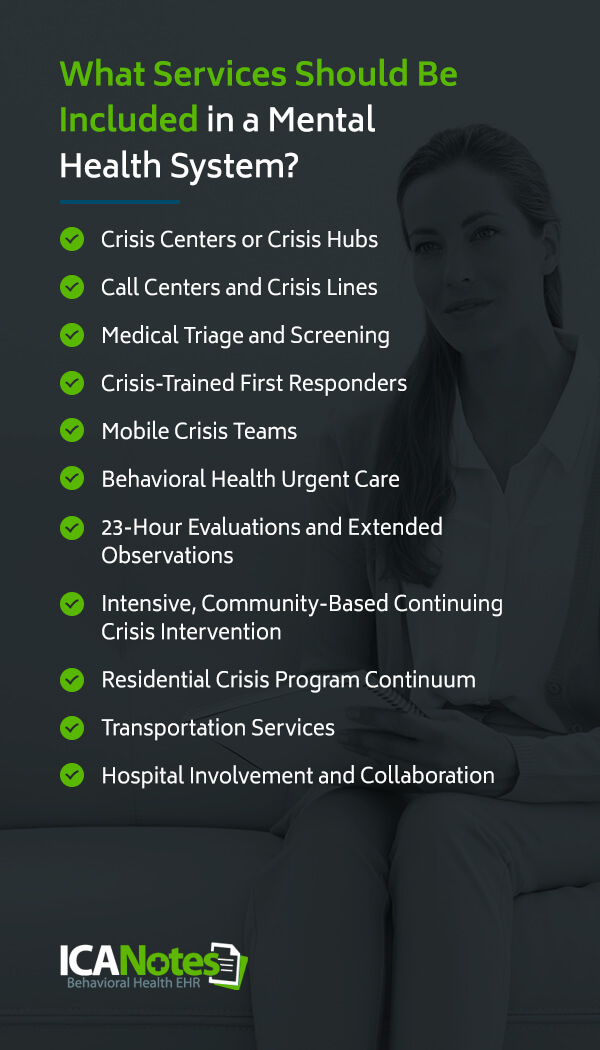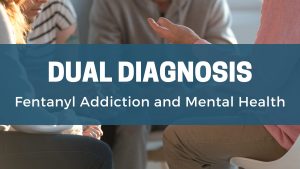Creating a Mental Health Crisis System
Mental health is a considerable issue for millions of Americans, many of whom struggle to find the support they need. In 2019 alone, 20.6% of American adults experienced mental illness, and just 44.8% of those adults received treatment. Some of those people will experience crisis events, which, if left unsupported, can lead to other issues. Those can include unnecessary law enforcement encounters, a lack of mental health care, substance use disorders, added stress to the individual and their loved ones, or added costs to the U.S. economy.
With such strong and wide-reaching effects, the need for a robust mental health crisis system is clear and present. But what goes into a mental health crisis system? And how do we ensure effective, equitable care to everyone in our communities with cost-effective operations?
The answer is multifaceted, but let's take a closer look.
Table of Contents
What Qualifies as a Mental Health Crisis?
The National Council for Behavioral Health (NCBH) defines a mental health crisis as a situation or event that poses potential or real disruption to a person's stability and safety. That risk comes due to behavioral health issues or conditions.
A mental health crisis may place the individual in a position where they can't care for themselves or might create a risk of harming themselves or those nearby.
These crises might not necessarily involve a call to emergency services such as 911, but they can begin whenever someone loses stability. An example might be a person experiencing severe thought disturbances that cause them to become paranoid or hostile.
The crisis continues until the person has been safely restabilized and connected with necessary supports and services. Any concerned person can call in a crisis request, including the individual experiencing the event, a caregiver, or a service provider.
Mental health crises can take on many forms, involving everything from severe depression and suicidal behavior to psychotic thoughts, hallucinations, and severe panic events.
What Is a Mental Health Crisis System?
A mental health crisis system is a collection of programs and services that collaborate to meet urgent and emergent behavioral health crisis needs. Ideally, the system would do so for as long as necessary for an entire community, regardless of culture, socioeconomic status, language, and other characteristics. This system could include programs such as:
- Mobile crisis teams
- Crisis residential units
- Emergency psychiatric services
Remember that a mental health crisis system is made up of more than just one of these programs. It should be built with many of them, all collaborating and interacting with each other. The goal is seamless and comprehensive supports with various touchpoints and services for the many types of mental health crises that can occur.
These organized programs should also collaborate within the community to provide accessibility to all individuals and their family members.
The ideal mental health crisis system should offer services with similar funding and intensity as other public services, like fire departments, emergency medical services (EMS), and law enforcement.
Upcoming Webinar

Adopting the Zero Suicide Framework
Tuesday October 19th 2021 | 12:00 PM EST
In this session, participants will gain a foundational understanding of the Zero Suicide Framework, the critical need for suicide-safer care in healthcare settings, and will begin to identify practice changes that align with best practices in suicide prevention. The role of the electronic health record in setting systems up for success in suicide-safer care will be highlighted.
Common Issues With Existing Mental Health Crisis Systems
In 2020, Americans identified mental health as the third most important health issue facing the nation, with public concern for mental health steadily rising. It's clearly seen as a significant issue, yet current mental health crisis systems face a myriad of complex problems that will take time to solve.
Some of the problems current systems face include:
- A lack of funding: Unfortunately, mental health services often don't get the same level of funding or support as standard medical care, though this can vary from state to state. In 2019, mental health services received 5.5% of all national health spending. While that number has risen significantly since 2009, it's still difficult for many mental health support services to find funding. This lack of funding can be a considerable barrier to offering quality services to all.
- Disparate programs: The ideal mental health crisis system should have interconnected and collaborative programs. Current systems are often disconnected. Law enforcement officers may not be well-trained on when to refer to psychiatric services. Existing mental health providers might not know how or have the resources to spend on community outreach, preventing them from increasing awareness about their services to people who need them.
- Inaccessibility: Despite 76% of Americans believing mental health is just as important as physical health, almost the same amount — 74% — believe these services are not accessible to everyone. One barrier to accessibility is insurance coverage. Many insurance providers do not cover appropriate mental health services, leaving many people, particularly those with low incomes, to forego their mental health care. Other issues include a lack of awareness, social stigmas, and limited options, which can disproportionality affect people from rural areas who may need to drive long distances for care.
- Unwelcoming or non-evidence-based care: Mental health services can be a stressful experience for many, especially those receiving involuntary interventions. Some mental healthcare providers do not focus on creating a welcoming, compassionate and trauma-free environment. They may also provide care without staying up-to-date with new research or best practices, resulting in poor care or out-of-date understandings of mental health.
Guiding Principles of an Ideal Mental Health System
When creating mental health systems, we must consider some essential guiding principles that help us avoid the problematic factors listed above. These principles, provided by the National Council for Behavioral Health, say an ideal mental health system should:
- Be based on a shared set of values: As a fundamental aspect of a strong mental health system, core values should form a focal point for every stakeholder and program involved. These values require a consensus and can include alignments toward recovery, accessibility, evidence-based service, continuous improvement, and person-first care. The system should include a regular assessment of these values.
- Be designed for complexity: As mental health professionals know, behavioral issues can have significant overlap with problems such as substance abuse, non-behavioral health issues, and cognitive disability. A strong system should factor in these co-occurring issues through collaborations and partnerships between different health services. It should also recognize the way these comorbid problems can affect the complexity of stabilization and prioritize different types of care as needed.
- Be cost-effective: With limited resources, mental health services need to consider their operation's efficiency. They should avoid the unnecessary use of expensive or restrictive mental health crisis interventions like arrests and hospitalizations. Funding usage should be like other safety-net services such as EMS and fire departments. While mental health is often supported by multi-payer funding, the National Council says it cannot succeed as an unfunded mandate. It must be a community obligation, engaging with funding sources such as the public, private insurers, county, and municipal funders and governments.
- Stay accessible: Mental health systems must offer equitable care to everyone, even those who may not traditionally have easy access to it. The system has a responsibility to engage with the community. It should provide service and outcomes for everyone in the community who needs help, regardless of age, linguistic background, socioeconomic status, and anything that may create difficulty when accessing help. The system must also take steps to assist those who may have trouble following conventional care practices, like showing up for appointments or engaging with care.
- Be clinically effective: Patients should be able to expect the same quality of care that people in medical crises receive. The goal is to achieve complete stabilization, not just avoid an arrest or a disturbance without addressing underlying problems. Other aspects of clinical effectiveness include working with the best available research and practice-based evidence. Providers can use measurements related to suicide prevention, interventions preventing arrest, and avoidance of hospitalization to judge effectiveness.
- Use value-based involuntary interventions: While not the ideal solution, involuntary intervention will be necessary for some patients. This experience can be upsetting, so in these instances, trauma-informed clinicians should treat patients with compassion and welcoming attitudes. Everyone involved must recognize the power differential that comes with involuntary interventions and take steps to minimize feelings of frustration and humiliation.
- Use shared data for continuous support: All of that collaboration between programs means health services should work together and share information. They should follow best practices for performance management and collect and share performance data. With all of this information, the entire system can better work toward continuous improvement.
What Services Should Be Included in a Mental Health System?
Mental health systems can involve a wide array of services and considered factors, but some examples include:
Crisis Centers or Crisis Hubs
These centerpieces of a mental health crisis system provide a place for people to go when experiencing a behavioral health crisis, whether they arrive on their own or are brought in by law enforcement or first responders.
Hubs can also be used as a centralized location for the coordination of crisis services within the community. They should be available 24/7 and may incorporate some of the services listed below, such as behavioral urgent care or call centers.
Call Centers and Crisis Lines
Call centers may include 911 call dispatch coordination and crisis call centers that people can call 24/7 for assistance with a behavioral health crisis. These centers should be linked up to the appropriate services to avoid confusion from having different service numbers.
Helplines are only effective if the community knows about them, so getting the word out is critical, as is easy access without long waits or many buttons to press.
Medical Triage and Screening
Medical screening is typically required before receiving mental health services and can often be excessive or inappropriate. Screening practices should follow guidelines regarding care, such as eliminating routine laboratory tests when unnecessary and identifying issues that require intervention or hospitalization.
Crisis-Trained First Responders
In many cases, law enforcement personnel and first responders are the primary points of contact for people in behavioral crises. If not properly trained, they can send people to the ER or jail unnecessarily. While the goal is to work with other services first, appropriate training is essential to ensure the right usage of crisis center tools and proper courses of action.
Mobile Crisis Teams
These teams can provide proactive engagement and outreach in a range of settings and meet people where they are without involving law enforcement or first responders. The goal is to de-escalate the crisis to allow for an initial evaluation and a consequent plan for follow-up.
Behavioral Health Urgent Care
Similar to medical urgent care services, these programs would offer easy access to crisis care without immediate intensive intervention. They can provide support for less immediate needs before the point of a crisis.
23-Hour Evaluations and Extended Observations
Observation programs provide a secure space for people to stay and be observed or evaluated by a multidisciplinary team during or shortly after a crisis.
Intensive, Community-Based Continuing Crisis Intervention
Most health crises are not resolved with a single intervention, and many individuals will require multiple support services or a "bridge" back to their regular lives.
Residential Crisis Program Continuum
Residential crisis programs can provide assistance to those who don't need inpatient or other secure treatment settings, providing less restrictive, more affordable care.
Transportation Services
Another aspect of psychiatric care is getting patients to and from the support services without restraint. Transportation creates accessible services, and a lack of restraint can make the individual in need of help feel more at ease.
Hospital Involvement and Collaboration
A crisis continuum involves support for patients who end up in emergency rooms and other hospital settings. Psychiatric emergency services (PES) can supply emergency departments (EDs) with dedicated emergency services.
How Can Mental Health Systems Be Evaluated?
One significant component of a mental health system is evaluation, helping system administrators understand performance outcomes and support continuous improvement. Traditional methods of measuring performance according to the Donabedian model include assessing:
- Structure: Structural assessments review the environment that care is delivered. Aspects might include medical recording and ordering methods, the number of board-certified physicians, and the ratio of providers to patients.
- Process: Reviewing processes involves looking at how the providers deliver care. Measures might include following best practices, screening tool processes, and interventions used. These results can provide information on what patients can expect when entering a facility for care.
- Outcomes: Outcomes allow us to understand the impact of the service on a patient's health. Outcome measurements for a mental health system might include hospitalization rates, housing situations, employment rates, and questionnaire results.
The effectiveness of measuring outcomes is dependent upon the ability of the responsible party to enact necessary changes. In essence, they need to have influence over the required resources to make valuable modifications to the system that will help more people and save money, among other benefits.
Incorporate Best Practices in Mental Health Facilities With ICANotes

Mental health systems require input and organization from many different stakeholders, including governments and other sources of funding. Getting any community to the point of having the ideal mental health crisis system is a long process, but facilities that work with mental health issues can start implementing effective strategies regardless of community engagement. Consider setting up community outreach and advertising strategies, assessing your outcome measurement methods, or improving connections to other community services.
Your electronic health record (EHR) can assist in making these changes. Improvements to your record-keeping strategies, easy outcomes measurement, and efficient charting, billing, and practice management tools help you make the most of limited resources. The ICANotes EHR offers these features and many others for behavioral health providers. Our knowledgeable team has a wide range of resources and support available for ICANotes users, clinicians, and anyone involved in mental health support services.
To learn more about ICANotes or how your EHR can play a role in mental health crisis systems, please reach out to us today.
Sources
- https://www.nami.org/mhstats
- https://www.thenationalcouncil.org/wp-content/uploads/2021/03/031121_GAP_Crisis-Report_Final.pdf?daf=375ateTbd56
- https://www.nami.org/Support-Education/Publications-Reports/Guides/Navigating-a-Mental-Health-Crisis/Navigating-A-Mental-Health-Crisis
- https://www.researchamerica.org/sites/default/files/Publications/RA_PollDataSummary_Booklet_screenRes.pdf
- https://openminds.com/intelligence-report/the-u-s-mental-health-market-225-1-billion-in-spending-in-2019-an-open-minds-market-intelligence-report/
- https://www.thenationalcouncil.org/press-releases/new-study-reveals-lack-of-access-as-root-cause-for-mental-health-crisis-in-america/
- https://www.ahrq.gov/talkingquality/measures/types.html














